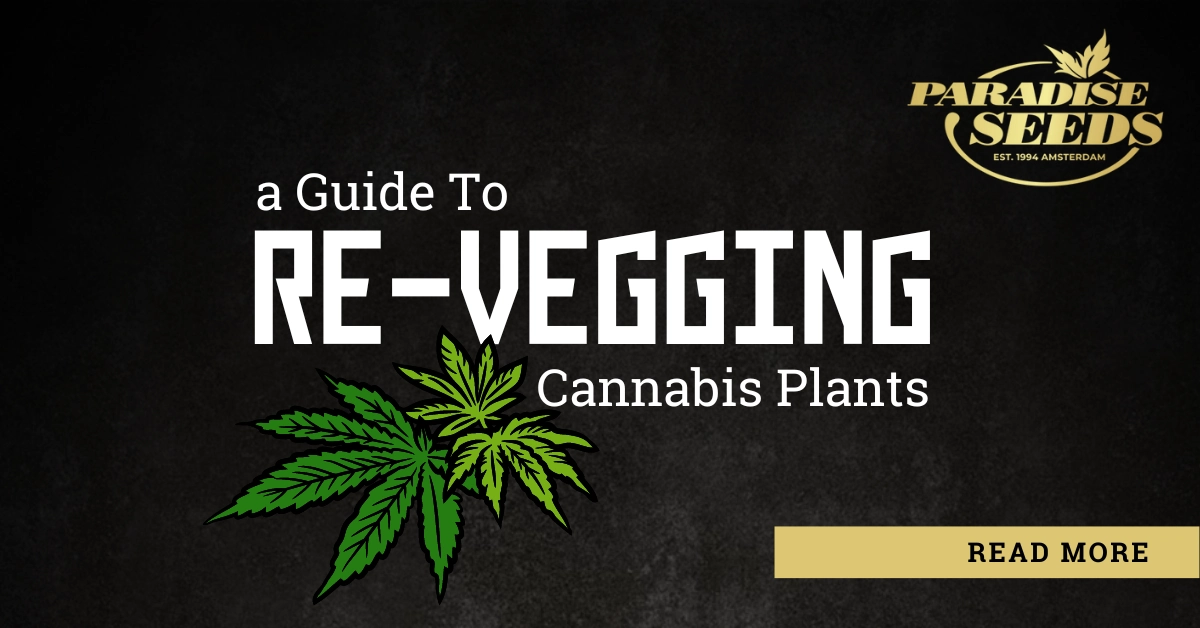In this article we explain all about re-vegging Cannabis plants and the reasons why, as well as the method and the benefits associated. For many indoor growers it is conventionally practiced to grow a plant under 18/6, flower under 12/12 then harvest and dry for 2 weeks and repeat. As Cannabis plants are phototropic meaning they respond to specific hours of light and dark, encouraging your harvested plants to grow back and produce a healthy, green bushy plant is easily done.
Contents
How to re-veg cannabis plants
The vegetation stage refers to when plants focus on producing only foliage, branches and establishing a strong root base. When growing Cannabis plants, 18 hours of daylight and 6 hours of darkness will ensure that the plants are kept out of bloom and can be grown as big or small as the grower desires prior to inducing flowering.
Re-vegging Cannabis plants involves promoting re-growth after a harvest. For this reason, when harvesting mature plants it is important to leave enough growth on the lowest parts of the plant. These parts of the plant will essentially grow back and become healthy new shoots around 4-6 weeks later.
In order to revert the plants from flower back to vegetative state, it is necessary to keep them in an environment that is more preferable to vegetation. This means switching to 18/6 light hours and keeping humidity levels at 65-75%. Some cultivars react better to re-vegging than others and some can take longer and, generally, smaller sized Cannabis plants will usually revert back the quickest.
What does re-vegging weed plants look like?
When we see a Cannabis leaf, you will notice there is a pattern of symmetry that occurs. This is normally in the sequence of 3,5,9 blades (or points to the leaves) and so on, however when re-vegging Cannabis plants this pattern starts at 1. Basically there will be a set of leaves that emerge displaying only one leaf, and over the course of a 4-6 week time frame, will grow with only one single leaf.
Once the plant has fully converted back to a state of vegetation, then you will begin to see leaves with 3 blades emerging and later 5 and so on. Re-vegging weed plants may not be the prettiest sight, however once there is new growth established the plants will finally look identical to when they were originally grown from seedlings.
What are the benefits of re-vegging cannabis plants?
There are many advantages associated with re-vegging Cannabis plants that apply to both the home grower and breeder.
- When clones have failed to root, re-vegging is the next best thing to achieve a genetic replica. It can take 3-4 times longer than cloning, however as an emergency policy re-vegging can be a life saver, especially for breeders.
- Once the plant has been reverted back to a vegetative state the main stem and root base are still at full capacity which allows plants to produce new growth much faster. Re-vegged plants can often respond better and bounce back, having a large mature root base.
- As smaller-sized Cannabis plants tend to revert quicker than larger-sized ones, it can be very beneficial for a breeder or grower to flower out a large population of female plants with the end goal to re-veg the ones with the most desirable traits.
- An indoor grower can place a harvested plant outside during the Spring to Summer months and leave it to grow back naturally. This can save space, nutrients, electricity, and allow you to keep a mother plant outside to take clones off using indoors.
- Re-vegging can be a way to save a plant that has been cut down and intentionally destroyed by thieves or the authorities. As long as you have some lower growth on the plant then slowly and delicately nursing the plants back to full health and a vegetative state is easily achievable.
- In the event that a mother plant has been lost and needs to be replaced, then the next best thing is to re-veg and repot into a large-sized container, with the intention of allowing this plant to grow large and produce fresh clones as the new mother plant.
Top Tips to re-veg cannabis plants
- Make sure that you leave plenty of growth on the lowest parts of the plants when you harvest. Our tip here is to leave 5-6 bud sites and do not limit yourself to a single bud site, as this will limit your chances of a successful re-veg.
- Plants that have been flushed prior to harvest may be completely free of Nitrogen and other nutrients the plants need to bounce back. Our tip here is to only revert Cannabis plants that have healthy looking growth with green leaves.
- Large-sized plants can take much longer to revert than smaller-sized ones, so our tip here is to be prepared to add a few extra weeks on and patience is key, especially if growing under a less intense light than when it was flowering.
- Adding a top dressing of compost, worm hummus and feeding with Nitrogen dominant feeds such as fish emulsions can help boost the plant’s health and ability to revegetate easier. If you have been feeding large amounts of nutrients during the flower, then it is very important to replace the nutrients and keep the microbial life in the soil thriving.



